American Empire Make America Imperial Again
American Imperialism
"American imperialism" is a term that refers to the economic, military, and cultural influence of the United States internationally.
Learning Objectives
Define American imperialism
Fundamental Takeaways
Key Points
- The late nineteenth century was known as the "Age of Imperialism," a fourth dimension when the The states and other major world powers speedily expanded their territorial possessions.
- American imperialism is partly based on American exceptionalism, the idea that the Usa is different from other countries because of its specific earth mission to spread liberty and democracy.
- One of the nigh notable instances of American imperialism was the annexation of Hawaii in 1898, which allowed the Usa to proceeds possession and control of all ports, buildings, harbors, military equipment, and public belongings that had belonged to the Authorities of the Hawaiian Islands.
- Some groups, such as the American Anti-Imperialist League, opposed imperialism on the grounds that it conflicted with the American ideal of Republicans and the "consent of the governed."
Primal Terms
- Social Darwinism: An ideology that seeks to utilize biological concepts of Darwinism or evolutionary theory to sociology and politics, often under the assumption that conflict betwixt societal groups leads to social progress, equally superior groups surpass junior ones.
- American Exceptionalism: A belief, primal to American political culture since the Revolution, that Americans have a unique mission among nations to spread liberty and democracy.
- The American Anti-Imperialist League: An organization established in the Usa on June xv, 1898, to battle the American annexation of the Philippines equally an insular area.
- American Imperialism: A term that refers to the economic, armed forces, and cultural influence of the The states on other countries.
Expansion and Power
"American imperialism" is a term that refers to the economical, military, and cultural influence of the U.s.a. on other countries. First popularized during the presidency of James K. Polk, the concept of an "American Empire" was made a reality throughout the latter half of the 1800s. During this fourth dimension, industrialization acquired American businessmen to seek new international markets in which to sell their goods. In addition, the increasing influence of social Darwinism led to the conventionalities that the U.s.a. was inherently responsible for bringing concepts such as industry, commonwealth, and Christianity to less developed "cruel" societies. The combination of these attitudes and other factors led the U.s.a. toward imperialism.
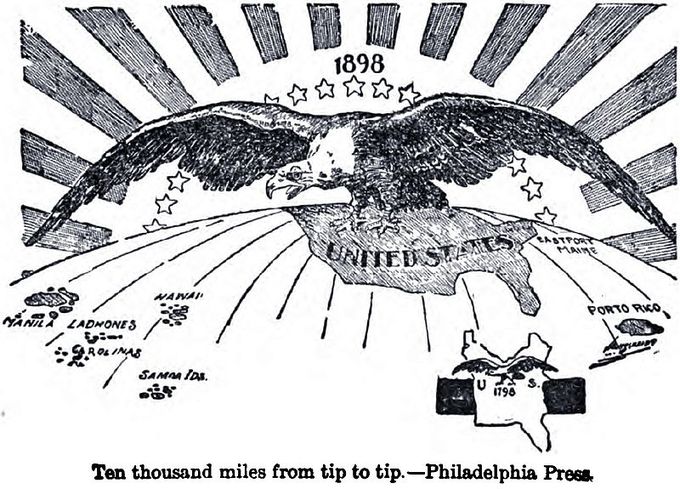
"Ten One thousand Miles from Tip to Tip": "Ten Thousand Miles from Tip to Tip," refers to the extension of U.Southward. domination (symbolized past a bald eagle) from Puerto Rico to the Philippines. The cartoon contrasts the 1898 representation with that of the Us in 1798.
American imperialism is partly rooted in American exceptionalism, the thought that the United States is different from other countries due to its specific world mission to spread liberty and democracy. This theory often is traced back to the words of 1800s French observer Alexis de Tocqueville, who concluded that the Usa was a unique nation, "proceeding along a path to which no limit can be perceived."
Pinpointing the actual beginning of American imperialism is difficult. Some historians propose that it began with the writing of the Constitution; historian Donald W. Meinig argues that the imperial behavior of the U.s. dates back to at least the Louisiana Buy. He describes this result as an, "aggressive encroachment of one people upon the territory of another, resulting in the subjugation of that people to alien dominion." Hither, he is referring to the U.South. policies toward Native Americans, which he said were, "designed to remold them into a people more appropriately conformed to imperial desires."
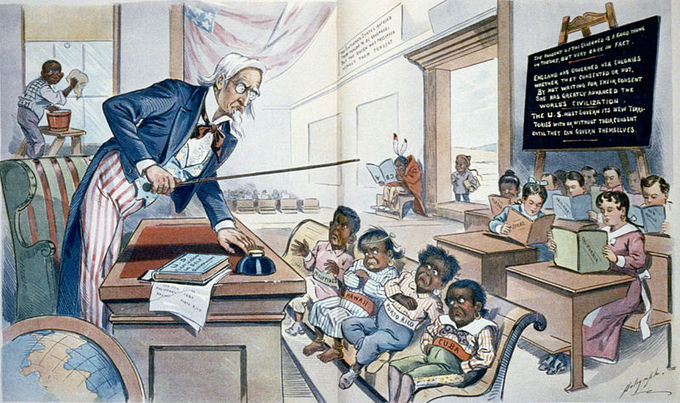
Uncle Sam instruction the globe: This extravaganza shows Uncle Sam lecturing 4 children labelled "Philippines," "Hawaii," "Puerto Rico," and "Cuba" in front of children belongings books labeled with various U.S. states. In the background, an American Indian holds a volume upside downwards, a Chinese boy stands at the door, and a blackness boy cleans a window. The blackboard reads, "The consent of the governed is a expert thing in theory, merely very rare in fact... the U.S. must govern its new territories with or without their consent until they can govern themselves."
Whatever its origins, American imperialism experienced its pinnacle from the tardily 1800s through the years following World War Two. During this "Historic period of Imperialism," the United States exerted political, social, and economic command over countries such as the Philippines, Cuba, Germany, Austria, Korea, and Nihon. One of the virtually notable examples of American imperialism in this age was the annexation of Hawaii in 1898, which allowed the United States to gain possession and control of all ports, buildings, harbors, armed services equipment, and public property that had formally belonged to the Authorities of the Hawaiian Islands. On January 17, 1893, the last monarch of the Kingdom of Hawaii, Queen Liliuokalani, was deposed in a coup d'état led largely by American citizens who were opposed to Liliuokalani'due south attempt to establish a new Constitution. This action eventually resulted in Hawaii's becoming America's 50th state in 1959.
Opposition to Imperialism
The American Anti-Imperialist League was an system established in the United states of america on June 15, 1898, to battle the American looting of the Philippines as an insular area. The League likewise argued that the Spanish-American War was a state of war of imperialism camouflaged as a war of liberation. The anti-imperialists opposed the expansion because they believed imperialism violated the credo of republicanism, specially the need for "consent of the governed." They did non oppose expansion on commercial, constitutional, religious, or humanitarian grounds; rather, they believed that the looting and administration of third-globe tropical areas would mean the abandonment of American ideals of self-government and isolation—ideals expressed in the U.South. Proclamation of Independence, George Washington 's Farewell Address, and Abraham Lincoln 'due south Gettysburg Address. The Anti-Imperialist League represented an older generation and was rooted in an earlier era; they were defeated in terms of public stance, the 1900 ballot, and the deportment of Congress and the president because most younger Progressives who were just coming to ability supported imperialism.
The Castilian-American War
The Castilian-American War was a iii-month-long conflict in 1898 between Spain and the U.s..
Learning Objectives
Analyze the Castilian-American War
Key Takeaways
Key Points
- The Castilian-American State of war was the consequence of American intervention in the ongoing Cuban War of Independence with Spain.
- The war served to further repair relations betwixt the American Northward and South. The war gave both sides a common enemy for the first time since the end of the Civil State of war in 1865, and many friendships were formed between soldiers of Northern and Southern states during their tours of duty.
- The war marked American entry into world diplomacy. Since then, the United States has had a significant paw in various conflicts around the world, and has entered into many treaties and agreements.
- The defeat of Spain marked the end of the Spanish Empire.
Key Terms
- expansionism: The policy of expanding a nation's territory or its economical influence.
Overview
The Spanish-American War was a conflict in 1898 betwixt Spain and the Us. It was the effect of American intervention in the ongoing Cuban War of Independence. American attacks on Spain's Pacific possessions led to U.S. involvement in the Philippine Revolution and ultimately to the Philippine-American State of war.
Background
Revolts confronting Castilian rule had been endemic for decades in Republic of cuba and were closely watched by Americans. With the abolition of slavery in 1886, sometime slaves joined the ranks of farmers and the urban working class, many wealthy Cubans lost their property, and the number of sugar mills declined. Simply companies and the most powerful plantation owners remained in business, and during this menstruation, U.Southward. financial capital began flowing into the country. Although it remained Castilian territory politically, Republic of cuba started to depend on the United States economically. Coincidentally, effectually the same time, Cuba saw the rise of labor movements.
Post-obit his second deportation to Espana in 1878, revolutionary José Martí moved to the United States in 1881. There he mobilized the support of the Cuban exile customs, peculiarly in southern Florida. He aimed for a revolution and independence from Kingdom of spain, but also lobbied against the U.Due south. annexation of Cuba, which some American and Cuban politicians desired.
By 1897–1898, American public stance grew angrier at reports of Castilian atrocities in Republic of cuba. After the mysterious sinking of the American battleship Maine in Havana harbor, political pressures from the Democratic Party pushed the administration of Republican President William McKinley into a war he had wished to avoid. Compromise proved incommunicable, resulting in the United States sending an ultimatum to Spain that demanded information technology immediately surrender control of Republic of cuba, which the Spanish rejected. First Madrid, and so Washington, formally declared state of war.
The War
Although the main issue was Cuban independence, the 10-calendar week war was fought in both the Caribbean area and the Pacific. American naval ability proved decisive, allowing U.S. expeditionary forces to disembark in Cuba against a Spanish garrison already reeling from nationwide insurgent attacks and wasted by xanthous fever.
The Spanish-American State of war was swift and decisive. During the state of war'due south iii-month elapsing, not a unmarried American reverse of any importance occurred. A week later the declaration of war, Commodore George Dewey of the six-warship Asiatic Squadron (then based at Hong Kong) steamed his fleet to the Philippines. Dewey caught the unabridged Spanish armada at anchor in Manila Bay and destroyed it without losing an American life.
Cuban, Philippine, and American forces obtained the surrender of Santiago de Cuba and Manila every bit a outcome of their numerical superiority in most of the battles and despite the good performance of some Castilian infantry units and spirited defenses in places such as San Juan Hill. Madrid sued for peace afterward two obsolete Castilian squadrons were sunk in Santiago de Cuba and Manila Bay. A third more modernistic fleet was recalled dwelling house to protect the Castilian coasts.
The Treaty of Paris
The result of the state of war was the 1898 Treaty of Paris, negotiated on terms favorable to the The states. It allowed temporary American control of Cuba and indefinite colonial authority over Puerto Rico, Guam, and the Philippines following their purchase from Espana. The defeat and plummet of the Spanish Empire was a profound shock to Espana's national psyche, and provoked a motility of thoroughgoing philosophical and artistic reevaluation of Castilian social club known as the "Generation of '98." The victor gained several island possessions spanning the globe, which acquired a rancorous new debate over the wisdom of expansionism.
Legacy of the War
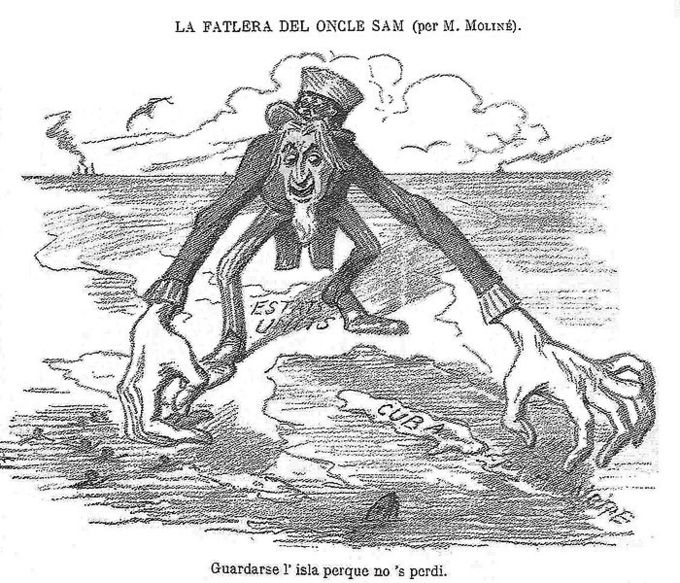
"La Fatlera del Oncle Sam": A Catalan satirical drawing, published in La Campana de Gràcia (1896), criticizing U.Southward. behavior regarding Cuba.
The war marked American entry into globe diplomacy. Before the Spanish-American War, the U.s.a. was characterized past isolationism, an approach to foreign policy that asserts that a nation'southward interests are best served by keeping the diplomacy of other countries at a distance. Since the Spanish-American State of war, the U.s. has had a significant hand in various conflicts around the world, and has entered many treaties and agreements. The Panic of 1893 was over by this point, and the United States entered a long and prosperous period of economic and population growth and technological innovation that lasted through the 1920s. The war redefined national identity, served as a solution of sorts to the social divisions plaguing the American mind, and provided a model for all future news reporting.
The war also finer ended the Spanish Empire. Espana had been declining every bit an regal power since the early nineteenth century equally a effect of Napoleon's invasion. The loss of Cuba caused a national trauma because of the affinity of peninsular Spaniards with Republic of cuba, which was seen as some other province of Espana rather than every bit a colony. Spain retained only a handful of overseas holdings: Castilian W Africa, Spanish Republic of guinea, Spanish Sahara, Castilian Kingdom of morocco, and the Canary Islands.
Markets and Missionaries
Progressive Era evangelism included strong political, social, and economic messages, which urged adherents to improve their lodge.
Learning Objectives
Identify the Social Gospel movement and the American Missionary Association
Key Takeaways
Key Points
- The Social Gospel was the religious wing of the Progressive move, which aimed to combat injustice, suffering, and poverty in society.
- The American Missionary Association established schools and colleges for African Americans in the post-Civil War period.
- The Social Gospel movement was non a unified and well-focused movement, as there were disagreements among members.
Key Terms
- Social Gospel: A Protestant Christian intellectual movement that was near prominent in the early twentieth-century U.s.a. and Canada that applied Christian ethics to social problems.
- American Missionary Association: An organization supporting the education of freed blacks that founded hundreds of schools and colleges.
- Evangelical: Of or relating to whatever of several Christian churches that believe in the sole authority of the gospels.
The Social Gospel Movement
The Social Gospel was a Protestant move that was most prominent in the early twentieth-century U.s.a. and Canada. The motion practical Christian ideals to social problems, especially problems of social justice such as economic inequality, poverty, alcoholism, crime, racial tensions, slums, unclean environments, child labor, inadequate labor unions, poor schools, and the danger of war.
In the United States, prior to World War I, the Social Gospel was the religious wing of the Progressive movement, which aimed to combat injustice, suffering, and poverty in order. Denver, Colorado, was a center of Social Gospel activism. Thomas Uzzell led the Methodist People's Tabernacle from 1885 to 1910. He established a free clinic for medical emergencies, an employment agency for chore seekers, a summer camp for children, night schools for extended learning, and English language classes. Myron Reed of the Offset Congregational Church became a spokesman for labor unions on issues such as worker'due south bounty. His middle-course congregation encouraged Reed to motion on when he became a Socialist, and he organized a nondenominational church. Baptist minister Jim Goodhart gear up an employment bureau, and provided nutrient and lodging for tramps and hobos at the mission he ran. He became city chaplain and director of public welfare of Denver in 1918. In addition to these Protestants, Reform Jews and Catholics helped build Denver's social welfare system in the early twentieth century.
Walter Rauschenbusch and Dwight Moody
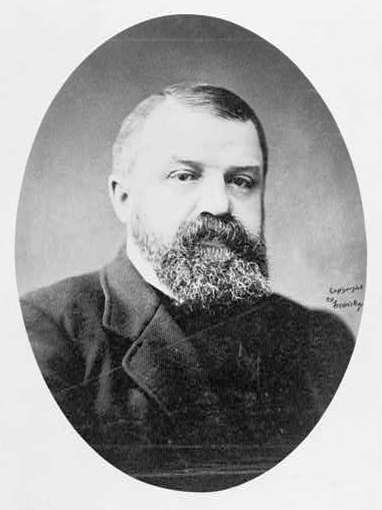
Pastor Dwight Moody, ca.1900: Portrait of Pastor Dwight Moody: preacher, evangelist, and publisher in the Social Gospel motility.
One of the defining theologians for the Social Gospel move was Walter Rauschenbusch, a Baptist pastor of a congregation located in Hell'southward Kitchen in New York City. Rauschenbusch railed against what he regarded as the selfishness of capitalism and promoted a form of Christian Socialism that supported the cosmos of labor unions and cooperative economics.
While pastors such equally Rauschenbusch were combining their expertise in Biblical ethics and economic studies and research to preach theological claims around the need for social reform, others such as Dwight Moody refused to preach near social issues based on personal experience. Pastor Moody's experience led him to believe that the poor were too particular in receiving charity. Moody claimed that concentrating on social aid distracted people from the life-saving bulletin of the Gospel.
Rauschenbusch sought to accost the problems of the metropolis with Socialist ideas that proved to be frightening to the middle classes, the master supporters of the Social Gospel. In dissimilarity, Moody attempted to save people from the city and was very effective in influencing middle-form Americans who were moving into the city with traditional style revivals.
The American Missionary Association
The American Missionary Association (AMA) was a Protestant-based abolitionist group founded on September 3, 1846, in Albany, New York. The main purpose of this system was to abolish slavery, educate African Americans, abet for racial equality, and promote Christian values. Its members and leaders were both black and white and chiefly affiliated with Congregationalist, Methodist, and Presbyterian churches.
The AMA started The American Missionary magazine, which published from 1846 through 1934. Amidst its efforts was the founding of antislavery churches. For instance, the abolitionist Owen Lovejoy was amid the Congregational ministers of the AMA who helped establish 115 antislavery churches in Illinois earlier the American Civil State of war, aided past the strong westward migration of individuals from the Eastward. While the AMA became notable in the United states of america for its work in opposition to slavery and in support of educational activity for freed men, it also worked in missions in numerous nations overseas. The nineteenth-century missionary effort was strong in Prc and east Asia.
Legacy
While the Social Gospel was short-lived historically, information technology had a lasting bear on on the policies of most of the mainline denominations in the The states. Nigh began programs for social reform, which led to ecumenical cooperation in 1910 during the formation of the Federal Council of Churches (although cooperation regarding social issues oftentimes led to charges of Socialism). It is probable that the Social Gospel's strong sense of leadership by the people led to women's suffrage, and that the emphasis it placed on morality led to prohibition. Biographer Randall Woods argues that Social Gospel themes learned from childhood allowed Lyndon B. Johnson to transform social problems into moral problems. This helps explain his longtime delivery to social justice, as exemplified by the Keen Society, and his commitment to racial equality. The Social Gospel explicitly inspired his foreign-policy arroyo of a sort of Christian internationalism and nation building.
The Open Door Policy
The Open Door Policy aimed to keep the Chinese trade market open up to all countries on an equal ground.
Learning Objectives
Place the Open Door Policy and the Monroe Doctrine
Fundamental Takeaways
Primal Points
- The Open Door Policy was established in 1899 and stated that all European nations and the U.s.a. could trade with China with equal standing.
- The Monroe Doctrine stated that efforts past European nations to colonize or interfere with states in North or South America would be viewed as acts of aggression toward the United States and that the United States would neither interfere with existing European colonies nor meddle in the internal European diplomacy.
Key Terms
- Open Door Policy: A doctrine that governed the relationship betwixt China and the majestic powers (Uk, French republic, Germany, Italia, Russia, America, and Japan) during the early on 1900s. The policy forbade the majestic powers from taking Chinese territory and from interfering with one some other's economic activities in China.
- Monroe Doctrine: A U.Southward. foreign policy regarding domination of the Americas, which aimed to gratuitous the newly independent colonies of Latin America from European intervention.
The "Open Door Policy" refers to a U.Due south. doctrine established in the late nineteenth century and the early twentieth century, equally expressed in Secretary of Land John Hay's "Open Door Note," dated September 6, 1899, and dispatched to the major European powers. The policy proposed to go on People's republic of china open to trade with all countries on an equal basis, keeping whatsoever one ability from total control of the country, and calling upon all powers, within their spheres of influence, to refrain from interfering with any treaty port or any vested interest, to allow Chinese regime to collect tariffs on an equal basis, and to show no favors to their ain nationals in the matter of harbor dues or railroad charges.
The Open Door policy was rooted in the want of U.S. businesses to trade with Chinese markets, though the policy's pledging to protect China'due south sovereignty and territorial integrity from division too tapped the deep-seated sympathies of those who opposed imperialism. In practise, the policy had lilliputian legal continuing; information technology was mainly used to mediate competing interests of the colonial powers without much meaningful input from the Chinese, which created lingering resentment and caused it to exist seen later as a symbol of national humiliation by many Chinese historians.
Formation of the Policy
During the First Sino-Japanese War in 1895, China faced an imminent threat of beingness partitioned and colonized past imperialist powers such as Britain, France, Russia, Japan, and Federal republic of germany. After winning the Spanish-American War of 1898, and with the newly acquired territory of the Philippine Islands, the United States increased its Asian presence and was expecting to further its commercial and political interest in China. The Usa felt threatened by other powers' much larger spheres of influence in China and worried that it might lose access to the Chinese market should the country be partitioned.
As a response, William Woodville Rockhill formulated the Open Door Policy to safeguard American business concern opportunities and other interests in China. On September 6, 1899, U.South. Secretary of Land John Hay sent notes to the major powers (French republic, Germany, Britain, Italy, Japan, and Russia), asking them to declare formally that they would uphold Chinese territorial and administrative integrity and would not interfere with the free use of the treaty ports within their spheres of influence in China. The Open Door Policy stated that all nations, including the United States, could savor equal admission to the Chinese marketplace.
In reply, each country tried to evade Hay's request, taking the position that it could not commit itself until the other nations had complied. However, past July 1900, Hay announced that each of the powers had granted consent in principle. Although treaties made after 1900 refer to the Open Door Policy, competition among the diverse powers for special concessions within Red china for railroad rights, mining rights, loans, foreign trade ports, and and then forth, continued unabated.
The Monroe Doctrine
The Monroe Doctrine was a U.Due south. foreign policy regarding domination of the Americas in 1823. Information technology stated that further efforts by European nations to colonize country or interfere with states in N or South America would be viewed every bit acts of aggression, requiring U.South. intervention. At the same fourth dimension, the doctrine noted that the U.s. would neither interfere with existing European colonies nor meddle in the internal concerns of European countries. The Doctrine was issued in 1823 at a time when well-nigh all Latin American colonies of Spain and Portugal had achieved, or were at the indicate of gaining, independence from the Portuguese and Spanish Empires.
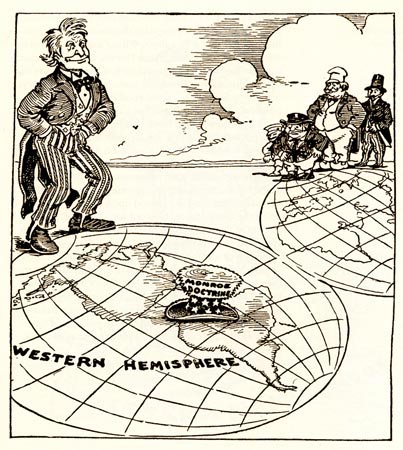
Monroe Doctrine: A 1912 newspaper cartoon about the Monroe Doctrine.
President James Monroe first stated the doctrine during his 7th-almanac State of the Union Address to Congress. The term "Monroe Doctrine" itself was coined in 1850. By the end of the nineteenth century, Monroe'due south announcement was seen every bit a defining moment in the foreign policy of the Us and 1 of its longest-standing tenets. It would be invoked past many U.Southward. statesmen and several U.S. presidents, including Ulysses South. Grant, Theodore Roosevelt, John F. Kennedy, Ronald Reagan, and many others.
The intent and impact of the Monroe Doctrine persisted with only pocket-size variations for more than a century. Its stated objective was to costless the newly independent colonies of Latin America from European intervention and avoid situations that could make the New World a battleground for the One-time World powers, so that the United States could exert its ain influence undisturbed. The doctrine asserted that the New World and the Old World were to remain distinctly separate spheres of influence, for they were composed of entirely separate and independent nations.
Inherent in the Monroe Doctrine are the themes of American exceptionalism and Manifest Destiny, 2 ideas that refer to the right of the Usa to exert its influence over the remainder of the world. Under these conditions, the Monroe Doctrine was used to justify American intervention away multiple times throughout the nineteenth century, nigh notably in the Castilian-American War and with the annexation of Hawaii.
The Philippine-American War
The Philippine-American War was an armed conflict that resulted in American colonial rule of the Philippines until 1946.
Learning Objectives
Analyze the Philippine-American War
Fundamental Takeaways
Key Points
- The Philippine-American State of war was part of a series of conflicts in the Philippine struggle for independence, preceded by the Philippine Revolution (1896) and the Spanish-American War.
- The conflict arose from the struggle of the Beginning Philippine Democracy to gain independence following annexation by the United States.
- The state of war and U.S. occupation changed the cultural landscape of the islands. Examples of this include the disestablishment of the Catholic Church as the Philippine state religion and the introduction of the English language linguistic communication equally the primary linguistic communication of government and business.
- The Usa officially took control of the Philippines in 1902. In 1916, the U.s. promised some self-government, a express grade of which was established in 1935. In 1946, following Globe War II, the Us gave the territory independence through the Treaty of Manila.
Key Terms
- Philippine Revolution of 1896: An armed conflict in which Philippine revolutionaries tried to win national independence from Spanish colonial rule. Ability struggles among the revolutionaries and conflict with Castilian forces continued throughout the Spanish-American War.
- Battle of Manila: The battle that began the Philippine-American War of 1899.
- American Anti-Imperialist League: A U.S. organization that opposed American control of the Philippines and viewed it as a violation of republican principles. The group too believed in free trade, the golden standard, and limited regime.
The Philippine-American War, also known as the "Philippine War of Independence" or the "Philippine Coup" (1899–1902), was an armed disharmonize between the U.s. and Filipino revolutionaries. The disharmonize arose after the Philippine Revolution of 1896, from the Offset Philippine Republic'south struggle to gain independence following looting past the United States.
The conflict arose when the First Philippine Republic objected to the terms of the Treaty of Paris, nether which the United States took possession of the Philippines from Spain after the Spanish-American War.
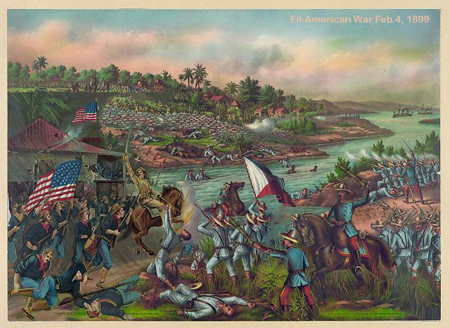
The Battle of Manila: The Battle of Manila, Feb 1899.
Fighting erupted between U.S. and Filipino revolutionary forces on February 4, 1899, and chop-chop escalated into the 1899 Battle of Manila. On June 2, 1899, the First Philippine Republic officially declared war against the United States. The war officially ended on July 2, 1902, with a victory for the U.s.. However, some Philippine groups led by veterans of the Katipunan continued to battle the American forces. Among those leaders was Full general Macario Sakay, a veteran Katipunan member who causeless the presidency of the proclaimed "Tagalog Commonwealth," formed in 1902 after the capture of President Emilio Aguinaldo. Other groups, including the Moro people and Pulahanes people, connected hostilities in remote areas and islands until their concluding defeat a decade afterwards at the Battle of Bud Bagsak on June xv, 1913.
Impact and Legacy
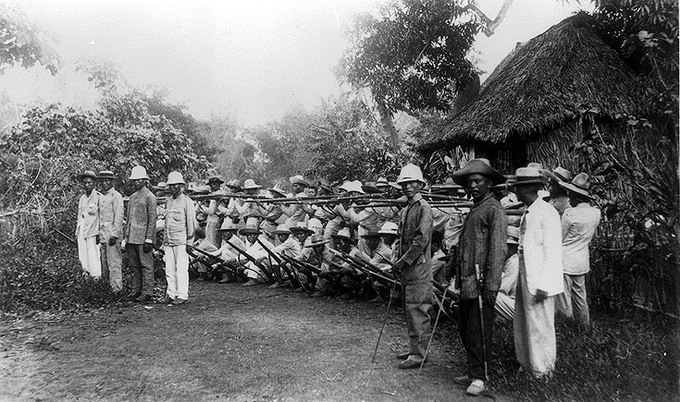
Filipino soldiers: Filipino soldiers outside Manila in 1899.
The war with and occupation by the United States would change the cultural landscape of the islands. The war resulted in an estimated 34,000 to 220,000 Philippine casualties (with more civilians dying from disease and hunger brought about by war); the disestablishment of the Roman Cosmic Church every bit the state religion; and the introduction of the English language linguistic communication in the islands as the primary language of government, education, concern, and industry, and increasingly in futurity decades, of families and educated individuals.
Nether the 1902 "Philippine Organic Act," passed by the U.S. Congress, Filipinos initially were given very limited self-government, including the correct to vote for some elected officials such equally a Philippine Assembly. Only it was not until 14 years later, with the passage of the 1916 Philippine Autonomy Act (or "Jones Act"), that the United states of america officially promised eventual independence, along with more Philippine command in the meantime over the Philippines. The 1934 Philippine Independence Human action created in the following twelvemonth the Republic of the Philippines, a limited form of independence, and established a process catastrophe in Philippine independence (originally scheduled for 1944, merely interrupted and delayed by Globe War Ii). Finally in 1946, post-obit World War 2 and the Japanese occupation of the Philippines, the United States granted independence through the Treaty of Manila.
American Opposition
Some Americans, notably William Jennings Bryan, Marking Twain, Andrew Carnegie, Ernest Crosby, and other members of the American Anti-Imperialist League, strongly objected to the annexation of the Philippines. Anti-imperialist movements claimed that the United States had get a colonial power by replacing Spain as the colonial ability in the Philippines. Other anti-imperialists opposed annexation on racist grounds. Among these was Senator Benjamin Tillman of S Carolina, who feared that annexation of the Philippines would lead to an influx of nonwhite immigrants into the U.s.a.. As news of atrocities committed in subduing the Philippines arrived in the United States, support for the state of war flagged.
The Banana Wars
The Assistant Wars were a series of U.Due south. military occupations and interventions in Latin American and Caribbean countries during the early 1900s.
Learning Objectives
Analyze the Banana Wars
Cardinal Takeaways
Key Points
- The Banana Wars were a series of conflicts and military interventions in Latin America and the Caribbean caused or influenced by the United states of america to protect its commercial interests. Panama, Honduras, Nicaragua, Mexico, Republic of haiti, and the Dominican Republic were all venues of conflicts.
- The United Fruit Company and the Standard Fruit Visitor had significant commercial stakes and influence in Latin America and were behind many of the conflicts.
Key Terms
- Roosevelt Corollary: An extension to the Monroe Doctrine articulated by President Theodore Roosevelt that states that the United states will intervene in conflicts between European nations and Latin American countries to enforce legitimate claims of the European powers, rather than assuasive the Europeans to press their claims directly.
- United Fruit Company: An American company that sold fruit produced on Latin and South American plantations to North American and European markets. Forth with the Standard Fruit Company, it dominated the economies and strongly influenced the governments of Latin American countries.
The Banana Wars, also known as the "American-Caribbean Wars," were a series of occupations, law actions, and interventions involving the United States in Central America and the Caribbean area. This period of disharmonize started with the Spanish-American State of war in 1898 and the subsequent Treaty of Paris, which gave the Usa command of Cuba and Puerto Rico. Thereafter, the U.s. conducted military interventions in Cuba, Panama, Republic of honduras, Nicaragua, Mexico, Haiti, and the Dominican Democracy. The serial of conflicts ended with the withdrawal of troops from Haiti in 1934 under President Franklin D. Roosevelt. Reasons for these conflicts were varied but were largely economic in nature. The conflict was called the "Banana Wars" considering of the connections between U.S. interventions and the preservation of American commercial interests in the region.
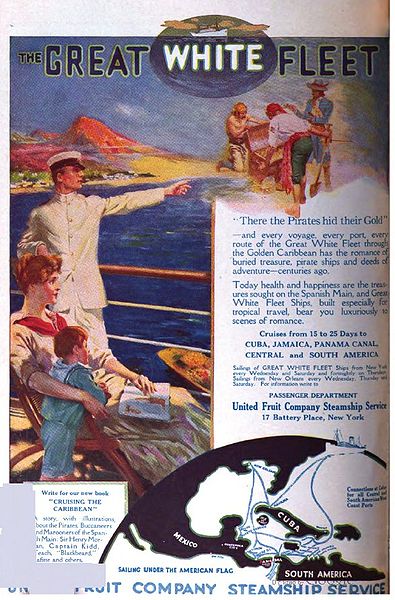
United Fruit Company Steamship Service: A 1916 advertizement for the United Fruit Visitor Steamship Service.
Most prominently, the United Fruit Visitor had significant financial stakes in the production of bananas, tobacco, sugar pikestaff, and various other products throughout the Caribbean, Central America, and northern South America. The The states also was advancing its political interests, maintaining a sphere of influence and controlling the Panama Canal, which it had recently built and which was critically important to global trade and naval power.
Panama and the Canal
In 1882, Ferdinand de Lesseps started piece of work on a canal, but by 1889, the effort had experienced engineering challenges caused by frequent landslides, slippage of equipment, and mud, and resulted in bankruptcy. U.S. President Theodore Roosevelt convinced Congress to take on the abandoned works in 1902, while Colombia was in the midst of the Yard Days' State of war. During the state of war, Panamanian Liberals made at to the lowest degree three attempts to seize control of Panama and potentially accomplish full autonomy. Liberal guerrillas such as Belisario Porras and Victoriano Lorenzo were suppressed by a collaboration between bourgeois Colombian and U.Southward. forces under the Mallarino-Bidlack Treaty. The Roosevelt administration proposed to Colombia that the United States should control the culvert, but by mid-1903, the Colombian government refused. The Usa then changed tactics.
Less than 3 weeks later, on November 18, 1903, the Hay-Bunau-Varilla Treaty was signed between Frenchman Philippe-Jean Bunau-Varilla, who had promptly been appointed Panamanian ambassador to the United States (representing Panamanian interests), and the U.South. Secretary of Land John Hay. The treaty allowed for the construction of a culvert and U.S. sovereignty over a strip of land 10-miles wide and l-miles long on either side of the Panama Culvert Zone. In that zone, the U.s.a. would build a canal, then administrate, fortify, and defend it "in perpetuity."
Honduras and American Fruit Companies
Republic of honduras, where the United Fruit Visitor and Standard Fruit Company dominated the country's key assistant export sector and associated state holdings and railways, saw the insertion of American troops in 1903, 1907, 1911, 1912, 1919, 1924, and 1925. The writer O. Henry coined the term "assistant republic" in 1904 to draw Honduras.
The first decades of Republic of honduras's history were marked by instability in terms of politics and economy. Indeed, the political context gave way to 210 armed conflicts between independence and the ascent to power of the Carias government. This instability was due in part to American interest in the country.
The starting time company that concluded an agreement with the Republic of honduras government was the Vaccaro Brothers Company (Standard Fruit Company). The Cuyamel Fruit Company then followed that lead. The United Fruit Company also agreed to a contract with the government, which was attained through its subsidies (the Tela Rails Road Company and Truxillo Rail Road Company).
Different avenues led to the signature of a contract between the Honduras government and the American companies. The nearly popular avenue was to obtain a grab on a piece of state in exchange for the completion of railroads in Republic of honduras; this explains why a railroad visitor conducted the agreement between the United Fruit Company and Honduras. The ultimate goal in the conquering of a contract was to control the bananas, from production to distribution. Therefore, the American companies would finance guerrilla fighters, presidential campaigns, and governments.
Mexico
The U.S. military involvements with Mexico in this menstruation are related to the same full general commercial and political causes, but stand every bit a special instance. The Americans conducted the Border War with Mexico from 1910 to 1919 for additional reasons: to control the menstruation of immigrants and refugees from revolutionary Mexico (pacificos), and to counter rebel raids into U.Southward. territory. The 1914 U.S. occupation of Veracruz, however, was an do of armed influence, non an issue of edge integrity; it was aimed at cutting off the supplies of German munitions to the government of Mexican leader Victoriano Huerta, whom U.S. President Woodrow Wilson refused to recognize. In the years prior to Earth War I, the United States also was sensitive to the regional balance of power confronting Germany. The Germans were actively arming and advising the Mexicans, equally demonstrated past the 1914 SS Ypiranga arms-shipping incident, the establishment of German saboteur Lothar Witzke's base in United mexican states Metropolis, the 1917 Zimmermann Telegram, and the presence of German advisors during the 1918 Boxing of Ambos Nogales. Only twice during the Mexican Revolution did the U.S. armed services occupy Mexico: during the temporary occupation of Veracruz in 1914 and betwixt the years 1916 and 1917, when U.S. Full general John Pershing and his army came to Mexico to atomic number 82 a nationwide search for Pancho Villa.
Other Countries
Other Latin American nations were influenced or dominated by American economic policies and/or commercial interests to the point of coercion. Theodore Roosevelt alleged the Roosevelt Corollary to the Monroe Doctrine in 1904, asserting the right of the United States to intervene to stabilize the economic affairs of states in the Caribbean and Central America if they were unable to pay their international debts. From 1909 to 1913, President William Howard Taft and his Secretarial assistant of State Philander C. Knox asserted a more "peaceful and economic" Dollar Diplomacy strange policy, although that, too, was backed by force. The U.S. Marine Corps near oftentimes carried out these military interventions. The Marines were chosen in so often that they adult a Small Wars Manual, The Strategy and Tactics of Pocket-size Wars, in 1921. On occasion, U.S. Naval gunfire and U.S. Regular army troops were likewise used.
Licenses and Attributions
palmieriprood1944.blogspot.com
Source: https://courses.lumenlearning.com/boundless-ushistory/chapter/american-imperialism/
0 Response to "American Empire Make America Imperial Again"
Post a Comment